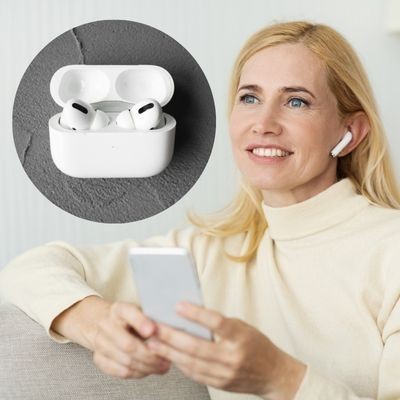
Head of Online Medical Content

Audiology Expert at Hearing Aid UK

Do Hearing Aids Work for Everyone?
Understanding who benefits and why the right support matters
Overview | Main types of hearing loss | When hearing aids help | When hearing aids might not help | The importance of testing | Conclusion
Overview
When you first start to explore hearing aids, one of the most common and important questions is, “Do hearing aids actually work for everyone?” It’s a fair question, as after all, hearing loss can vary enormously from person to person, and no one wants to invest in something that might not be right for them.
The short answer is: hearing aids can work for most people, but not necessarily everyone. If you want to know whether they’ll work for you, it ultimately depends on a few key factors, including the type and severity of your hearing loss, your overall ear health, and your expectations.
In this article, we will provide some generic guidance and insight into hearing loss, who would benefit from wearing hearing aids, and when hearing aids might not work as well as expected.
Not all hearing loss is the same
First, it’s important to understand that hearing loss isn’t a one-size-fits-all ideology. There are different types, including:
Sensorineural hearing loss:
The most common type, usually age-related or caused by noise exposure, affecting the inner ear or auditory nerve.Conductive hearing loss:
Caused by blockages or damage in the outer or middle ear, such as wax build-up, fluid, or infection.Mixed hearing loss:
A combination of both sensorineural and conductive issues.
Hearing aids are particularly effective for sensorineural hearing loss, which is why they’re often recommended for age-related hearing problems. In cases of conductive loss, however, medical or surgical treatment might be needed first, and a hearing aid might only be part of the solution.
Related reading: Types of hearing loss
How and when hearing aids help
Modern hearing aids are clever things. They don’t just make sounds louder, they use advanced digital processing to enhance speech, reduce background noise, and adapt to different environments. Many now come with Bluetooth connectivity, allowing you to stream phone calls, music, or TV audio straight to your ears.
But here’s the catch: hearing aids don’t restore hearing to “normal.” They’re not like putting on a pair of glasses and instantly seeing clearly again. Instead, they amplify sound in a way that helps your brain make better sense of what it’s hearing.
For many people, especially when fitted and adjusted properly, hearing aids can make a huge difference, with clearer conversations, less effort in noisy settings, and better engagement with daily life.
When hearing aids might not work as expected
There are a few scenarios where hearing aids might not work well, or at all.
Profound or total hearing loss:
For those with little or no remaining hearing ability, especially in both ears, traditional hearing aids may not offer much benefit. In these cases, cochlear implants or other assistive devices might be more appropriate.Cognitive decline or auditory processing issues:
Sometimes the ears pick up sound, but the brain struggles to interpret it. People with certain neurological conditions may find hearing aids less effective because the brain isn't able to process the improved sound clearly.
Poor fit or adjustment:
Hearing aids need to be tailored to your specific hearing profile. If they’re not programmed correctly, or if the physical fit isn’t right, they can feel uncomfortable, underperform, or even amplify the wrong sounds. This is why it is important to find the right hearing aid provider for you whom you can trust.
Unrealistic expectations:
This one’s important. Hearing aids take time to get used to. If you’re expecting them to magically “fix” your hearing overnight, you may end up disappointed. It often takes a few weeks (or longer) of wearing them regularly to get the full benefit.
The importance of a professional hearing test
This is why seeing a qualified hearing care professional is essential. In the UK, audiologists and hearing aid dispensers will carry out a full hearing test, talk through your lifestyle and needs, and help you understand your options.
They can also advise you if you’re a good candidate for hearing aids or if another route might be more suitable. For example, if your hearing loss is caused by something as simple as impacted earwax, a hearing aid won’t help, but a quick removal could sort the issue completely.
Related reading: Earwax removal, buildup, and cleaning
The right support makes all the difference
One thing many people underestimate is how much support matters. Buying hearing aids online or off-the-shelf might be cheaper, but without proper fitting, follow-ups, and adjustments, it’s easy to end up with devices that don’t do the job.
At Hearing Aid UK, for instance, we offer home visits, aftercare, and ongoing support to make sure your hearing aids keep working as they should, and that you’re confident using them in day-to-day life. That level of care can be the difference between a frustrating experience and a life-changing one.
So, do hearing aids work for everyone? Key takeaways...
Hearing aids can be incredibly effective for many people, but they’re not a one-size-fits-all solution. The success of hearing aids depends on the cause of your hearing loss, how much hearing you have left, the quality of the fitting, and your own patience in adapting to them.
If you’re not sure whether hearing aids are right for you, the best place to start is with a free hearing test and a chat with a professional. You might be surprised by what modern hearing technology can do and how much difference it can make to your everyday life.
Why Choose Us?
- FREE Hearing Tests
- Best Hearing Aids and Prices
- FREE Aftercare for Life
- FREE Home Visits
- 200+ Local Audiologists
- 60 Day Money Back Guarantee
Ready to take the first step towards better hearing?
Find the right hearing aid for you
Hearing aids can make a real difference, but only when they’re matched to your unique hearing needs and fitted with expert care. Whether you’re just starting to notice changes in your hearing or exploring options for a loved one, we’re here to help.
Book your free hearing test today and speak to a qualified professional who can guide you through your options with no pressure, just honest advice. Because better hearing doesn’t start with guesswork, it starts with understanding.
Other hearing aid advice articles you might like...
 Do Hearing Aids Work for Everyone?
Do Hearing Aids Work for Everyone?  Wearing Hearing Aids with Glasses
Wearing Hearing Aids with Glasses  Risks of Wearing Apple AirPod Pro 2's
Risks of Wearing Apple AirPod Pro 2's Our specialist service includes:
Do not spend hundreds of pounds without getting a second opinion from us.
Please call us on 0800 567 7621
 Not only are the prices great, but the service is fantastic! Many thanks to your team.
Not only are the prices great, but the service is fantastic! Many thanks to your team.What's included in our hearing aid prices?
Other pages you might find useful
If you are looking at this page then it is likely that an audiologist has suggested that you purchase this particular hearing aid, so is this the best model for you?
In general, any audiologist will always recommend to you the model that best suits your needs. Here is a useful checklist to make sure that is the case.
- Audiologist level of knowledge: The audiologist you have seen will hopefully have a wide knowledge of all available hearing aids, however, some will only be familiar with a small number of brands and therefore may not really be in a position to know which model is the best for you. It is OK to challenge their recommendation and ask them to justify why this particular brand is the one for you.
- Do research: Read about the hearing aid that was recommended. Does it seem like it will suit your lifestyle? Does it have more or fewer features than you need?
- Be aware of sales targets: Many high street retailers have specific tie-ins to a particular manufacturer/brand. The hearing aid they have suggested may still be the correct one for you, but do your research so that you know why they might have recommended it.
If in doubt, feel free to give us a call. That's what we're here for. In the meantime, read all about our review of the best hearing aids for 2025 here
If you have significant hearing loss in both ears, you should be wearing two hearing aids. Here are the audiological reasons why:
Localisation: The brain decodes information from both ears and compares and contrasts them. By analysing the minuscule time delays as well as the difference in the loudness of each sound reaching the ears, the person is able to accurately locate a sound source. Simply put, if you have better hearing on one side than the other, you can't accurately tell what direction sounds are coming from.
Less amplification is required: A phenomenon known as “binaural summation” means that the hearing aids can be set at a lower and more natural volume setting than if you wore only one hearing aid.
Head shadow effect: High frequencies, the part of your hearing that gives clarity and meaning to speech sounds, cannot bend around your head. Only low frequencies can. Therefore if someone is talking on your unaided side you are likely to hear that they are speaking, but be unable to tell what they have said.
Noise reduction: The brain has its own built-in noise reduction which is only really effective when it is receiving information from both ears. If only one ear is aided, even with the best hearing aid in the world, it will be difficult for you to hear in background noise as your brain is trying to retain all of the sounds (including background noise) rather than filtering it out.
Sound quality: We are designed to hear in stereo. Only hearing from one side sounds a lot less natural to us.
Fancy some further reading on this topic? You can read about why two hearing aids are better than one in our article, hearing aids for both ears, here
For most people, the main benefit of a rechargeable hearing aid is simple convenience. We are used to plugging in our phones and other devices overnight for them to charge up. Here are some other pros and cons:
For anybody with poor dexterity or issues with their fingers, having a rechargeable aid makes a huge difference as normal hearing aid batteries are quite small and some people find them fiddly to change.
One downside is that if you forget to charge your hearing aid, then it is a problem that can't be instantly fixed. For most a 30-minute charge will get you at least two or three hours of hearing, but if you are the type of person who is likely to forget to plug them in regularly then you're probably better off with standard batteries.
Rechargeable aids are also a little bit bigger and are only available in Behind the Ear models.
Finally, just like with a mobile phone, the amount of charge you get on day one is not going to be the same as you get a few years down the line. Be sure to ask what the policy is with the manufacturer warranty when it comes to replacing the battery.
Looking for more information on rechargeable hearing aids? Read our dedicated page on the topic here
For most people, the answer is yes. But it's never that simple.
The majority of hearing problems affect the high frequencies a lot more than the low ones. Therefore open fitting hearing aids sound a lot more natural and ones that block your ears up can make your own voice sound like you are talking with your head in a bucket. Therefore in-ear aids tend to be less natural.
However the true answer is we can't tell until we have had a look in your ears to assess the size of your ear canal, and until we have tested your hearing to see which frequencies are being affected.
People with wider ear canals tend to have more flexibility, also there are open fitting modular CIC hearing aids now that do not block your ears.
There is also the age old rule to consider, that a hearing aid will not help you if it's sat in the drawer gathering dust. If the only hearing aid you would be happy wearing is one that people can't see, then that's what you should get.
Most people can adapt to any type of hearing aid, as long as they know what to expect. Have an honest conversation with your audiologist as to what your needs are.
Generally speaking, six or more. Unless it's none at all.
The number of channels a hearing aid has is often a simplistic way an audiologist will use to explain why one hearing aid is better than another, but channels are complex and it is really not that straightforward. Here are some reasons why:
Hearing aids amplify sounds of different frequencies by different amounts. Most people have lost more high frequencies than low and therefore need more amplification in the high frequencies. The range of sounds you hear are split into frequency bands or channels and the hearing aids are set to provide the right amount of hearing at each frequency level.
Less than six channels and this cannot be done with much accuracy, so six is the magic number. However, a six channel aid is typically very basic with few other features and is suitable only for hearing a single speaker in a quiet room. The number of channels is not what you should be looking at, it's more the rest of the technology that comes with them.
As a final note, different manufacturers have different approaches. One method is not necessarily better than any other. For example, some manufacturers have as many as 64 channels in their top aids. Most tend to have between 17 and 20. One manufacturer has no channels at all.
Hearing aids are easily lost, misplaced or damaged and typically are one of the most expensive personal possessions an individual can own. We offer hearing aid warranty coverage for £80 per year per aid. Find out more about this service we provide here
All our audiologists use the very latest technology and provide the full range of tests to accurately measure your hearing for free. Find out about what hearing healthcare services we offer all our customers here
Hearing Aid UK offers all their customers free home visiting services, even in a care home environment, for no extra cost. Including hearing tests, fittings, maintenance, check-ups and much more in the comfort of your own home and at your convenience. Find out more information about our home visits here
Here, at Hearing Aid UK, we are dedicated to offering low hearing aid prices. We achieve this by having no head office and low marketing costs. Our hearing aid prices are amongst the lowest you will find anywhere in the world. Explore our prices, brands, and models here
Other pages you might find useful
Ask the Experts
6 Morton Lane
Walkwood
Redditch
Worcestershire
B97 5QA
Latest Launch
When we refer to a product as 'Latest Launch', we mean it is the latest to be released on the market.
New
When we refer to a product as 'New', we mean that the product is the newest hearing aid model on the market.
When we refer to a product as 'Superseded', we mean that there is a newer range available which replaces and improves on this product.
Older Model
When we refer to a product as an 'Older Model', we mean that it is has been superseded by at least two more recent hearing aid ranges.
